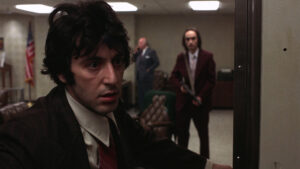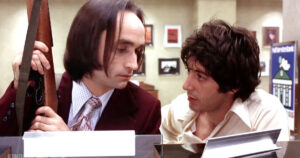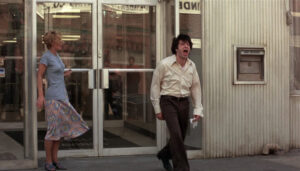“Dog Day Afternoon” – Robbery with a Human Face

Title: “Dog Day Afternoon”
Release Date: 1975
Director: Sidney Lumet
Cast: Al Pacino, John Cazale, Charles Durning, Chris Sarandon, James Broderick, Carol Kane
“Dog Day Afternoon” by Sidney Lumet is a fact-based story of a failed bank robbery in 1972 in New York. The film, which won an Oscar for its screenplay, is not only a recreation of those events, but, above all, delves into the motivations of the criminals, becoming both psychological and social cinema. Indeed, just as important as the personal stories of the thieves turns out to be the overall context in which the robbery takes place: class inequality, police brutality and the predations of the media machine. Sensational performances in “Dog Day Afternoon” were created by Al Pacino and John Cazale.
“Dog Day Afternoon” – August 22, 1972 in New York
The story shown in the movie “Dog Day Afternoon” happened on August 22, 1972 in New York. In the late afternoon, John Wojtowicz and two aides robbed one of the banks in Brooklyn. Unfortunately, it quickly became apparent that the safe contained a negligible amount of money, and the police were on the scene in no time. Wojtowicz cited a desire to help a loved one financially as the main motive for the robbery. These events inspired Sidney Lumet to make the film. The Oscar-winning screenplay was written by Frank Pierson, and Al Pacino and John Cazale were cast in the leading roles.
In “Dog Day Afternoon,” Pacino is named Sonny and is the “brains” of the whole operation. From the beginning, however, nothing goes according to plan: Steve, the driver who is supposed to be in charge of securing the getaway, resigns from his participation in the heist just after crossing the bank’s doors, the safe is almost empty, and setting fire to the daily balance book triggers a suspicious smoke that alarms the police. The thieves are therefore trapped in the bank with the hostages and wonder what to do next.

Surprisingly, Sonny gains the sympathy of the facility’s employees, as well as onlookers gathered around the building. He takes advantage of the media’s presence at the scene, reminds the crowd of the recent Attica prison massacre, and scatters marked banknotes. The public and even the hostages seem to be rooting for the thieves. It also soon comes to light that Sonny is bisexual, and wanted to use some of the stolen money for a sex change operation for his close friend. So the hero decides to start making demands on the police….
“Dog Day Afternoon” – socio-political background
“Dog Day Afternoon” is one of Sidney Lumet’s best movies and also one of the most fruitful results of the director’s collaboration with Al Pacino, who starred in his great picture “Serpico” two years earlier. A notable strength of the bank robbery story is the subtle balance of comic and dramatic elements. Especially the beginning abounds in funny situations, exposing the peculiar amateurism of the robbers. Narratively, the film seems to be divided into two parts: the first, until Moretti (Charles Durning) leads the case, is a dynamic sequence of sensational events. From the time FBI agent Sheldon (James Broderick) enters the action, on the other hand, the comedy clearly gives way to the increasing drama of events.
Negotiations with the thieves and concessions end. Sheldon turns off the electricity and air conditioning in the building, forcing Sonny to make more decisive decisions. At the same time, the fast-paced action of the first part slows down noticeably. We see Sonny having two long phone conversations: with his wife and with his homosexual friend Leon (Chris Sarandon), meeting his hysterical mother and writing his will. So while the first part of “Dog Day Afternoon” implements the principles of crime cinema and outlines the social context of the story, the second part exposes its existential and psychological dimensions.

The general background is in keeping with the specifics of the mid-1970s in the United States. The political warp of the time is the citizens’ distrust of authority caused by the famous Watergate affair. It is significant that the main division in the film is not between criminals and law-abiding citizens, but between the police (identified with those in power) and the rest of society. Both the hostages and the crowd watching the events at the bank seem to favor Sonny more than Detective Moretti. The protagonist senses these moods very accurately, so he shouts the word “Attica” to the onlookers – he is referring to the prison where 40 people were shot. Chanting the slogan “Attica” thus has a dimension of discord and distrust of politics.
In turn, the gesture of throwing money toward the crowd is in keeping with Americans’ widespread dissatisfaction with social inequality. Sonny makes clear the reasons for the robbery he made: a meager salary is not enough for anyone to ensure a decent existence. When he proclaims this simple truth in a televised interview he gives over the phone, the call is immediately dropped. Indeed, the role of the predatory media is to seek cheap sensationalism and tone down public discontent, not to show reality. The media maintain the myth of the “American dream” in the minds of citizens and censor anything that does not fit into it.
The movie “Dog Day Afternoon” – a human tragicomedy
“Dog Day Afternoon” is brilliantly played out on a general human dimension. This is because we have the opportunity to look a little closer at thieves, that is, people who break the law, and especially the motivations that cause them. Sonny is a bravura performance by Al Pacino: thoroughly human, at times lost, but nevertheless smart and with a false hope of improving his lot, he arouses the viewer’s sympathy. The way he treats the hostages earns him their favor and even a kind of trust. Perhaps they get the impression that Sonny is one of them – an ordinary man, with ordinary dreams: he just wants to have money, which is impossible to get with honest work. The readability of the protagonist and the simplicity of his rationale mean that his final defeat can even be regretted with a circulating saying: “the wind is always in the poor man’s eyes.”

John Cazale, on the other hand, does a good job in the role of the extremely introverted Sal. At first his determination to get the loot at any cost arouses resentment. Nevertheless, he too has completely human dilemmas: he feels fear because he has never flown in an airplane, doesn’t smoke lest he get cancer and believes that the body is God’s temple. The man also wins the sympathy of the hostages, so much so that at the airport one of the girls hands him a rosary to give the thief courage during the flight. In a way, Sal’s plan comes to fruition: for he would rather die than go to jail and is indeed shot.
Sonny’s story ends differently. When an FBI agent puts a barrel to his temple, he asks not to shoot. Despite everything, he chooses life, even though everything he dreamed of has splintered at the last moment. And perhaps therein lies the hope of “Dog Day Afternoon” – in spite of the final news of a long sentence in prison, life still goes on and is worthwhile, even on a slightly derailed track.
Literature:
A. Garbicz, „Kino, wehikuł magiczny. Przewodnik osiągnięć filmu fabularnego. Podróż piąta 1974 – 1981”, Kraków 2009.
„1000 filmów, które tworzą historię kina”, pod red. P. Kletowskiego, 2021.
